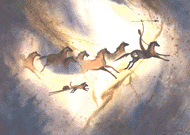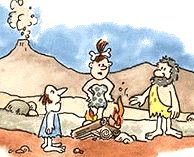A BRIEF HISTORY OF FIRE AND ITS USES - by Ed Semmelroth
THROUGH the centuries there has been such an intimate connection of fire with the cultural growth of humanity that whatever relates to the antiquity of fire is important in tracing- the history of early progress.' And because all inventions make use of what has gone before, the steps, which lead up to the making of the first stoves, are necessary in writing of their history.
Logically, of course, we may assume there was once a time when man had no fire, but very early he must have become acquainted with fire derived from natural sources, and made use of it; for no remains of man's art show him without fire as his companion. Much later in the scheme of things he invented processes for making fire artificially.
Many of the legends or myths relating to the origin of fire are vivid and dramatic, and while they vary in detail there appears to be a similarity in many of the episodes that form the fire-origin story in all countries of the world.'
Stealing fire from the gods, one of the first incidents, was made more or less exciting by the strategy employed in acquiring, it. Prometheus, for example, stole fire from the heavens in a hollow tube, one of the feats which gave him the reputation of being a great benefactor of men.'
After the transportation of fire was solved, it was occasionally borrowed, and while the meaning is lost, the phrase is still used when one says: "May I borrow a light?"'
CURFEW OR "FIRE-COVER"
With the acquisition of fire came the problem of preserving, it and interesting examples of the ingenuity of man were presented. First, the fire was buried; preserved in the ashes of the fire itself. Next, a type of slow-match or fire-stick was developed, and later, when man worked with metals, the curfew, or "fire-cover" was invented. The coals were raked together and collected in the chimney recess; the curfew set over them, preserving the fire until morning.' Those surviving are of sheet brass having perforations, and a handle.
Beating drums was one of the earliest methods used to tell members of a community that it was curfew time. The use of bells for this purpose is also of great antiquity, and in 1068, during the reign of William the Conqueror, the bells were rung by law, at seven in the evening, so that all might cover the fire and extinguish the lights. This also prohibited nocturnal assemblies.
Henry 1 repealed this law about 1100, but bells' have continued to be rung for curfew until very modern times. In the United States, an ordinance establishing a curfew was adopted by many towns in colonial days and existed until the first quarter of the 20th Century. In the later years it provided in general that children under 15 should not frequent the streets after 9 o'clock in summer and 8 o'clock in winter. In April 1943 the curfew law was again invoked in Massachusetts so that no one under 17 could be on the streets after 11 p. m. during the existence of dim-out regulations.
Fires -needed watching, not only to keep them from going out, but from spreading, or theft, so a fire-keeper was delegated to the work, thus starting a social organization.
The early fires also formed a nucleus for human grouping, and became tribal or communal fires, from which the individual family fires derived.
Symbolic and superstitious uses of fire have been common to all faces, and at an early period the altar fires were kept sacred - the symbol of religion - but as time went on the significance gradually lessened, and finally the hearth became the center- of the home, with its hospitality and good cheer.' So through the centuries the lure of fire has remained one of the strongest instincts of the human race.
When possible the communal fire was placed in front of a rock shelter or cave; in a place safe and convenient for the use of everyone, and the necessity for a screen to protect the early bonfires from the wind may have been the reason for the round form of house thought to be the earliest.' Later individual fires were built in the center of the family shelters, where the hearth became known as the chimney. The term, chimney, then was used to include the hole or flue which carried off the smoke of the fire burning- in a pit in the center of the floor.
History has failed to record the inventor, or to tell the place where chimneys as we might recognize them were first used, but they seem to have been common in Venice before the middle of the 14th Century, for- a number of them were thrown down by an earthquake there in 1347."
And chimneys apparently were built in Padua before 1368, for in that year Francesco de Carrao, Lord of Padua, with a large retinue arrived in Rome. There were no chimneys in the inn where he stayed, and the smoke from the fire (built in a hole in the floor) was just too much for him. So he had two chimneys built by workmen (masons and carpenters) he brought with him (anticipating the situation, no doubt) and over the chimneys he placed his arms."
In England, the oldest actual remains of chimneys are supposed to be those of Winwall House, Not-folk, and of Kenilworth and Conway Castles, built in the 12th Century."
Leland, in his Itinerary, mentioned those of Bolton Castle: "One thing I muche notyed in the haulle of Bolton, how chimneys were conveyed by tunnels made on the sides of the walls bytwixt the lights in the haulle, and by this means, and by no covers, is the smoke of the bai-tbe in the haulle wonder strangely conveyed."
During the reign of the Tudors, chimneys became a prominent and beautiful architectural feature, but even while Elizabeth was queen, apologies were made to guests if they could not be given rooms with chimneys, and ladies were often sent to the neighbors where they could enjoy this luxury, available for some time only in the homes of the wealthy.
In the homes of the common
People the fire was still being kindled against a hob of clay in the back or center of the room. Only part of the smoke which filled the room ever found its way out through the opening- in the roof or wall, sometimes only a few feet above the level of the hearth."
Wattle and clay chimneys were being erected as late as 1621, when a Mr. Skinner of Sudbury, England was ordered to "amend his dangerous chimney," and afterwards were fined for not doing it. This caused the following -General order by
The court: That no man shall elect and build up any chimney within the borough but only of brick, and to be builded above the roof of the house fower feete and a halfe, upon the pain for every such offense to be here-After committed the summe of vl."
On April 7, 1719 other clay chimneys were ordered to be rebuilt of brick."
In the New England colonies, chimneys on the first houses were built of wood. Logs or sticks were placed one above another at right angles, and plastered with clay or mortar, and roofs were thatched with reeds or flags.'7
Great exposure to fire was always imminent with this style of building-, although chimneys and roofs were subject to frequent inspection by officers detailed for the duty.
The first fire in the town of Boston occurred on the 16th of March, 1631 from the imperfect claying of one of the cattied" chimneys, and two buildings were destroyed.
Later, officers known as "firewards" were appointed by the justices of peace and selectmen of the towns from time to time, and were distinguished by a staff five feet in length, colored red, and headed by a brass spire six inches long."
Governor Dudley prohibited wooden chimneys and thatched roofs, and they were also forbidden in the Dutch colony at Manhattan.
Despite the law, inflammable materials must have continued long in use, for President Washington, in his tour of the eastern states in 1789, considered the fact that dwellings generally hid stone or brick chimneys an item worthy of record in his diary.
The principles of the chimney were but poorly understood for many years. No matter how perfect they seemed the builders were never sure they wouldn't smoke, and with a mysterious pertinacity the smoke which should -o up, came down. For a long time too, so-called chimney doctors (who professed to remedy smoky chimneys) flourished; engaged in what today would be termed a racket."
The first recorded effort to study the matter of smoky chimneys on a scientific basis was that of Louis Savot, a physician of Paris, during the 16th Century. He failed to find the real trouble, although he did improve the form of the fireplace opening by narrowing the width, so that less air could enter on each side of the fire. And he showed that the flue should be smooth to lessen the friction of the ascend-ing smoke.
Benjamin Franklin spent a great deal of time trying to find a cure for smoky chimneys, and after his reputation as an heating expert had been established, he complained that wherever he visited he was asked to remedy one.
He repeatedly spoke of the disadvantages of the large fireplace, and the necessity of the chimney-cloth (a contrivance placed at the upper opening of the fireplace to lower the opening) to keep smoke from coming out into the room.
In his pamphlet published in 1745, Franklin listed the inconveniences of the large fireplace, when he wrote:
"They almost always smoke, if the door were not left open. They require a large funnel, and a large funnel carries off a great quantity of air, which occasions -hat is called a strong draft to the chimney, without which strong draft the smoke would come out of some part or other of so large an opening, so that the door can seldom be shut; and the cold air so nips the backs and heels of those that sit before the fire."
Used with permission...written by Ed Semmelroth,
www.antiquestoves.com - Illustrations by Sandy Sandy



